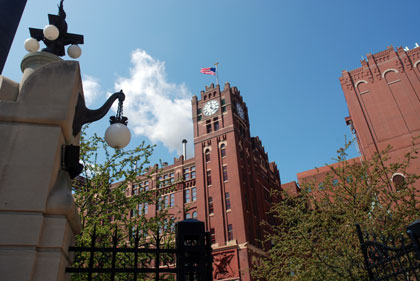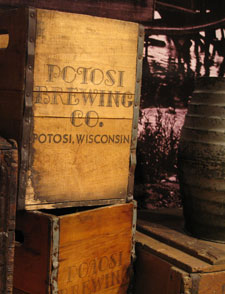 Doug Hoverson writes this:
Doug Hoverson writes this:
A brewery in a small town has a distinctive place in the life of the locality and its citizens. The smokestack and other brewery structures tower over the neighbourhood. The brewery’s taproom is one of the centers of communal life. The beer itself, whether bearing on the label the name of the place or one of the leading families, maybe be one of the few ways that anyone outside of the area has ever heard of the town. On a more personal level, everyone either is employed by the brewery, or knows someone who is. Old-timers have stories about long hours and occasional accidents, and argue about whether the beer is really as good as it used to be. The brewery is a point of pride as well as an engine of the local economy. When a small town loses its brewery, it loses part of its life as well as a large portion of its livelihood.
And Susan Appel this:
Old breweries still stand, some renovated and adapted to new uses, but other abandoned and neglected, often for decades. The longer that continues, the more common it is that they fall apart or are demolished.
As a result, too few examples stand today as testament to the skills and extraordinary impact of dedicated pre-Prohibition American brewery architects. The rise of these specialists appears to have been a function of the intersection of American architecture and the American brewing industry when both were in significant periods of their histories.
Appel edited a special issue of Brewery History, the journal of the Brewery History Society in the UK, focusing on American brewery architecture. Her contribution, “Edmund Jungenfeld of St. Louis and His Impact on 19th-Century American Brewery Architecture” provides and anchor for the issue. In another chapter, Rich Wagner writes about another architect, Otto C. Wolf of Philadelphia, whose work was also prominent before Prohibition. Two others focus on caves and their connection with early American lager brewing. And at the end Hoverson examines the restoration of Potosi Brewing in Potosi, Wisconsin, back into an operating brewery as well as the National Brewery Museum.
For the May gathering of The Session, Reuben Gray will ask participants to write about “Local Brewery History.” I’ll be quoting from this issue then, both from what Appel writes about the National Historic Landmark — the landmarked area at Anheuser-Busch includes 189 structures on 142 acres — a 20-minute drive from my house and from Craig Williams’ article about the Lemp brewery cave, which is pretty much right across the highway from A-B.
 And I’m pretty sure I will be revisiting Hoverson’s article often. It nicely summarizes why it matters to a town when a going business disappears. He writes, “The story of Potosi’s brewery from 1852-1972 is important not because it was unique, but rather because it was typical of the founding, growth and decline of so many American breweries.” The brewery outlasted most and was still making a profit when the Schumacher family closed the doors, the “next generation” no longer interest in keeping it going. Not only did 45 brewery workers lose their jobs, but there were the ripple effects. Railroad business at the depot declined, local businesses that supplied the brewery and its workers closed. And, one employee of a tavern said, “while we will still be able to get it (nearby Huber Brewing bought some of the brands) it just won’t be the same. It won’t be a local beer.”
And I’m pretty sure I will be revisiting Hoverson’s article often. It nicely summarizes why it matters to a town when a going business disappears. He writes, “The story of Potosi’s brewery from 1852-1972 is important not because it was unique, but rather because it was typical of the founding, growth and decline of so many American breweries.” The brewery outlasted most and was still making a profit when the Schumacher family closed the doors, the “next generation” no longer interest in keeping it going. Not only did 45 brewery workers lose their jobs, but there were the ripple effects. Railroad business at the depot declined, local businesses that supplied the brewery and its workers closed. And, one employee of a tavern said, “while we will still be able to get it (nearby Huber Brewing bought some of the brands) it just won’t be the same. It won’t be a local beer.”
*****
Should Hoverson’s name seem familiar, he is author of two books you should own: “Land of Amber Waters: The History of Brewing in Minnesota” and the upcoming history of breweries in Wisconsin (yes, I am that confident about how good it will be).
Copies of the Beer History American architecture issue may be ordered here.
It’s interesting how the first quote does and doesn’t play out today — Three Floyds, say, is invisible (but for the customer lines) in Munster, IN, architecturally. Yet Half Acre is a prominent presence on Lincoln Ave. in Chicago — not a small town, but still, the brewery is a landmark for the neighborhood it’s situated in. The second quote: I think the former Pabst brewery in Milwaukee has become a boutique hotel, and parts of the Blatz brewery are now apartments or condos.
We see similar trends in the Pacific Northwest also. The Seattle Malting & Brewing Co buildings in the South Seattle Georgetown neighborhood is one example. It was once the 6th largest brewery in the world headed into Prohibition.
It has since served as the original home to Georgetown Brewing (purveyors of Manny’s Pale Ale) until they moved into a bigger space nearby. Today, Machine House Brewing brews up authentic English style ales there and Fran’s Chocolates is building out their new factory in and behind the old brew house. I’m glad they are keeping history alive and hope the new construction blends in with the charming old red brick.